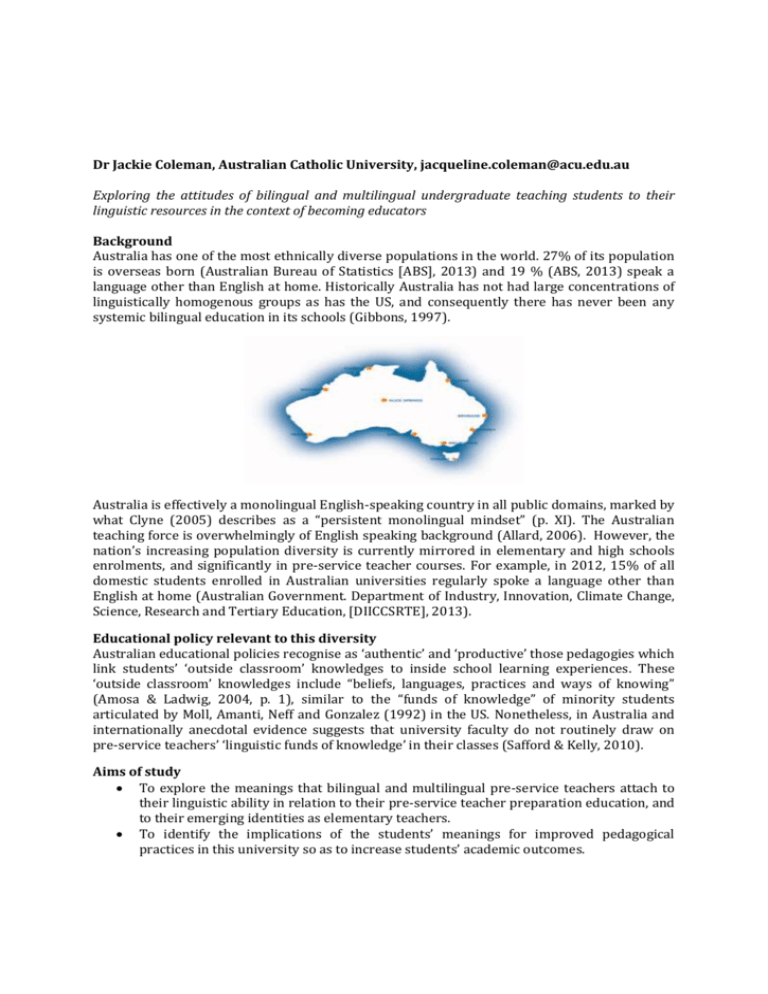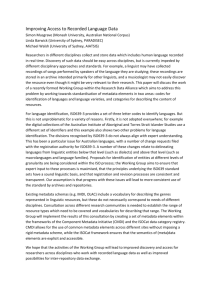Link - Literacy Research Association
advertisement

Dr Jackie Coleman, Australian Catholic University, jacqueline.coleman@acu.edu.au Exploring the attitudes of bilingual and multilingual undergraduate teaching students to their linguistic resources in the context of becoming educators Background Australia has one of the most ethnically diverse populations in the world. 27% of its population is overseas born (Australian Bureau of Statistics [ABS], 2013) and 19 % (ABS, 2013) speak a language other than English at home. Historically Australia has not had large concentrations of linguistically homogenous groups as has the US, and consequently there has never been any systemic bilingual education in its schools (Gibbons, 1997). Australia is effectively a monolingual English-speaking country in all public domains, marked by what Clyne (2005) describes as a “persistent monolingual mindset” (p. XI). The Australian teaching force is overwhelmingly of English speaking background (Allard, 2006). However, the nation’s increasing population diversity is currently mirrored in elementary and high schools enrolments, and significantly in pre-service teacher courses. For example, in 2012, 15% of all domestic students enrolled in Australian universities regularly spoke a language other than English at home (Australian Government. Department of Industry, Innovation, Climate Change, Science, Research and Tertiary Education, [DIICCSRTE], 2013). Educational policy relevant to this diversity Australian educational policies recognise as ‘authentic’ and ‘productive’ those pedagogies which link students’ ‘outside classroom’ knowledges to inside school learning experiences. These ‘outside classroom’ knowledges include “beliefs, languages, practices and ways of knowing” (Amosa & Ladwig, 2004, p. 1), similar to the “funds of knowledge” of minority students articulated by Moll, Amanti, Neff and Gonzalez (1992) in the US. Nonetheless, in Australia and internationally anecdotal evidence suggests that university faculty do not routinely draw on pre-service teachers’ ‘linguistic funds of knowledge’ in their classes (Safford & Kelly, 2010). Aims of study To explore the meanings that bilingual and multilingual pre-service teachers attach to their linguistic ability in relation to their pre-service teacher preparation education, and to their emerging identities as elementary teachers. To identify the implications of the students’ meanings for improved pedagogical practices in this university so as to increase students’ academic outcomes. Participants and Methodology The study will follow a cohort of pre-service teachers during the course of their undergraduate study. First year pre-service teachers were identified from enrolment data indicating their bilingualism or multilingualism. An initial demographic survey instrument was used, followed by semi-structured interviews in this first phase of the study. Narrative Analysis and Critical Discourse Analysis were used to focus on both narrative and non-narrative units and hierarchies within the interview data which indicated student positionalities and the discourses they invested in with regard to their ‘linguistic funds of knowledge.’ Themes derived from analysis Articulating ‘linguistic funds of knowledge’ Two aspects broadly described as structure or grammar, and meaning (Bialystok, 2012) were articulated by participants. Some spoke of consciously employing explicit knowledge of language structure or ‘grammar’ derived from their multilingualism. Others saw no relationship between their languages (that is, no metalinguistic skills derived from multilingualism or bilingualism). The majority indicated explicit understandings that words and combinations of words in languages encode ‘meanings’ embedded in cultural norms. Growing up in an English-only school system In general, the elementary and high school teachers of the participants had positioned their bilingualism or multilingualism as a deficit. Many students commented that their L1 proficiency had been directly eroded by their experiences in Australian schools which promoted subtractive bilingualism (Lambert, 1975). Impacts of growing up in an English-only school system? “I had to pick one [language]. If I picked Chinese, I’m still going to be bullied, going to be disliked, with no friends. But if I picked English I can be better. But then I forgot about Chinese!” (Hu, Mandarin, Fujianese and English speaker) Acceptance of ‘English-only’ teacher education School education may have prepared students to tacitly accept a teacher education program which replicates their school experiences. They appeared not to realise and critique, but rather to accept, the practices of an educational system which sustain the English monolingualism of the socially powerful (including school and university faculty), often at the cost of their students’ non-English L1 proficiency. Students appear to accept the invisibility or marginalisation of their ‘linguistic funds of knowledge’ at university, and its implicit corollary that English is the only valuable linguistic capital for higher education, and accordingly, for informing their evolving elementary teacher identities. In this sense, they are ‘receptive’ (Bourdieu, 1977) to faculty acting within the ‘language marketplace’ (Bourdieu, 1977) as mediators of linguistic correctness, that is, of English monolingualism in higher education. Students’ comments indicated investment in wider social discourses such as the ‘unexamined’, ‘naturalised’ discourse (Fairclough, 1995) of the obviousness and common sense of English-only as the medium of all academic education, and as the sole valuable linguistic constituent of their emerging identities as elementary teachers. Accessing ‘linguistic funds of knowledge’ at university? “I don’t think it’s an issue for me” (Mariam-Arabic & English speaker). “Not really relevant” (Frances-Cantonese& English speaker) Drawing the themes together The meanings that students attach to their ‘linguistic funds of knowledge’ are reflective of the institutional practices they reported at this university, and also of the wider social context and discourses of which the university is a part. Being bilingual or multilingual has no part to play in informing students’ pre-service teacher identities. This suggests that the development of their identities as Australian elementary teachers, that is, as English-speaking teachers in an English-medium education system, may rely on the suppression or marginalization of their multilingual selves. Thus, institutional practices and students’ own ‘meanings’ in interaction are resulting in less than optimal educational opportunities for these linguistically diverse preservice teachers, and incidentally for their English-monolingual pre-service teacher peers. Implications: Towards improved pedagogy in pre-service teacher education programs Structured opportunities to disrupt the habitus of students and faculty Create structured opportunities for faculty and students (both multilingual and monolingual) to interrogate the assumptions underlying the ‘monolingual reductionism’ (Skutnabb-Kangas, 2000) of institutional practices and habitus in which implicit English monolingual norms are rarely questioned or reflected on in terms of how they may affect or limit the educational participation and outcomes of linguistically diverse students, their identity formation (and affirmation), and their ultimate academic achievement. Modelling of ‘productive’ pedagogy through the creation of ‘Identity texts’ This could occur across subjects through adaptations and implementation of the pedagogy of creating ‘Identities texts’ reported by Cummins and Early (2011). This would serve the dual purposes of affirming the identities and ‘linguistic funds of knowledge’ of bilingual and multilingual pre-service teachers before their university teachers and monolingual peers, and also equally importantly, act to model ‘productive’ and ‘authentic’ pedagogies for use with their future linguistically diverse elementary students. Protocols for interrogating course content Development of protocols by faculty to interrogate the content, positionalities, privilegeings and silences in relation to linguistic diversity within pre-service teacher education subjects, and the assigned text books for these subjects. Teaching Second Language Acquisition (SLA) research outcomes as core content Explicit teaching of SLA theory and research outcomes as core content of undergraduate programs including, for example, the Common Underlying Proficiency Hypothesis (Cummins, 1981), Additive and Subtractive Bilingualism (Lambert, 1975) and studies which have established the cognitive benefits of multilingualism (Adesope, Lavin, Thompson & Ungerleider, 2010). At present at this university, SLA outcomes are included in undergraduate elective, rather than core, subjects, and in post-graduate qualifications. Teaching of SLA research outcomes would powerfully and publically articulate “a ‘counter-discourse’ to the implicit devaluation of [diverse] students’ abilities, languages [and] cultures” (Cummins & Early, 2011, p. 4) within the university space. Administrative Steps Within this overall process of change in pedagogical and institutional practices, the university could take administrative steps to position student multilingualism more visibly, for example, passing on data about students’ ‘linguistic funds of knowledge’ to teaching staff as a matter of course at the start of each semester. The university may also act on the advice of Nieto (2000) in the US who contends that universities should “rethink admissions requirements” and “[give] priority to candidates who are fluent in at least one language other than English” (p. 183). Such a measure taken by a socially prestigious institution like a university could potentially have a very powerful effect on socially pervasive discourses which frame non-English L1s as deficits in contemporary Australia. References Adesope, O. O., Lavin, T., & Thompson, T., Ungerleider, C. (2010). A Systematic Review and MetaAnalysis of the Cognitive Correlates of Bilingualism. Review of Educational Research, 80(2), 207-245. Allard, A. (2006). "A bit of a chameleon act": A case study of one teacher's understanding of diversity. European Journal of Teacher Education 29(3), 319-340. Amosa, W., & Ladwig, J. (2004). Examining Non-dominant Cultural Perspectives in Pedagogical Practice. Paper presented at the Australian Association for Research in Education Conference, Melbourne. Australian Bureau of Statistics. (2013). Cultural Diversity in Australia. Retrieved from http://www.abs.gov.au/ausstats/abs@.nsf/Lookup/2071.0main+features902012-2013 Australian Government. Department of Industry, Innovation, Climate Change, Science, Research and Tertiary Education. (2013). All Domestic Students by Language Spoken at Home, Type of Attendance and Gender, Full Year 2012. Retrieved from http://www.innovation.gov.au/highereducation/HigherEducationStatistics/Pages/Over viewOfHigherEducationStatisticsCollections.aspx Bialystok, E. (2012). The Bilingual Brain. Retrieved from http://www.abc.net.au/radionational/programs/allinthemind/search/?query=Bialysto k Bourdieu, P. (1977). Outline of a theory of practice. Cambridge, UK: Cambridge University Press. Clyne, M. (2005). The social responsibility and impact of the linguist/applied linguist in Australia. Paper presented at the Conference of the Australian Linguistic Society, 2005. Cummins, J. (1981). The role of primary language development in promoting educational success for language minority students. In: Schooling and language minority students: A theoretical framework. (pp. 3-49) Sacramento: California State Department of Education. Cummins, J., & Early, M. (Eds.). (2011). Identity Texts: the collaborative construction of power in multilingual schools. Stoke-on-Trent, UK: Trentham. Fairclough, N. (1995). Critical discourse analysis: the critical study of language. London, New York: Longman Gibbons, J. (1997). Australian bilingual education. In: J. Cummins & D. Corson (Eds.), Encyclopedia of language and education. (Vol. 5: Bilingual Education) (pp. 209-215). Amsterdam: Kluwer Educational Publishers. Lingard, B., Ladwig, J., Mills, M., Bahr, M., Chant, D., Warry, M., . . . Luke, R. (2001). The Queensland School Reform Longitudinal Study. Brisbane: Education Queensland. Moll, L. C., Amanti, C., Neff, D., & Gonzalez, N. (1992). Funds of Knowledge for Teaching: Using a Qualitative Approach to Connect Homes and Classrooms. Theory Into Practice, 31(2), 132-141. Nieto, S. (2000). Placing Equity Front and Center: Some Thoughts on Transforming Teacher Education for a New Century. Journal of Teacher Education, 51(3), 180-187. Safford, K. & Kelly, A. (2010). Linguistic capital of trainee teachers: knowledge worth having? Language and Education, 24(5), 401–414 Skutnabb-Kangas, T. (2000). Linguistic genocide in education-or worldwide diversity and human rights? Mahwah, N J: Lawrence Erlbaum Associates.





